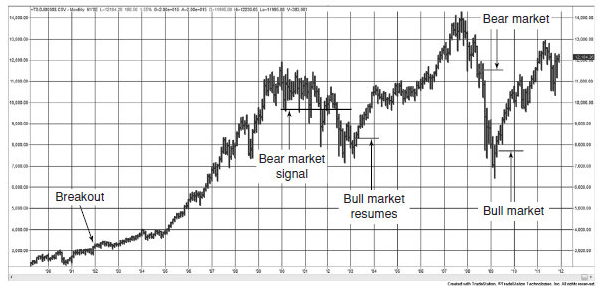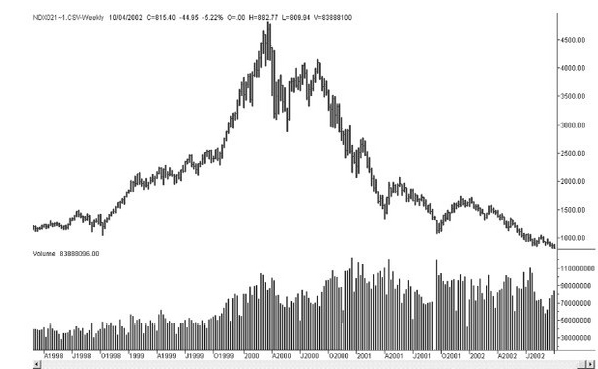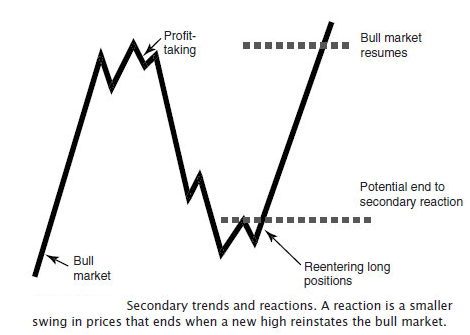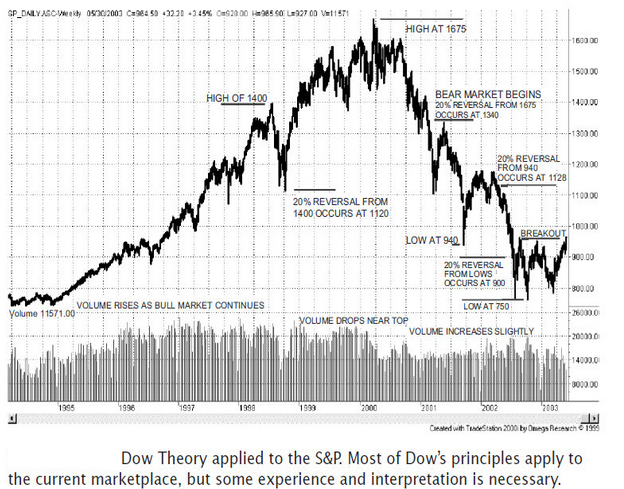Are you searching for the Dow Theory PDF, or the dow theory forecasts or the dow jones theory
or simply what to know what is dow theory?
This article will simplify the complexities of dow theory so that you can really understand what the dow jones theory is all about in 7 minutes (unless you are a very slow reader!)
But here’s the thing…
- dow theory was developed initially by Charles Dow to trade stocks.
- Charles Dow was the first guy to create and index of similar stocks-the Industrials and Railroads in the year 1897-these are now the Dow Jones Industrial Average.
What has Dow Jones Theory got to do with Forex Trading?
A lot actually…
Well the fact of the matter is that the Dow Theory is still the foundation of Technical Analysis and it can be used in stock/share markets, commodities, forex and lots of other markets.
I found an article explaining the dow theory which I like so I am posting it here as there is no need to reinvent the wheel. Even though the explanation of the dow theory in here refers to indexes and stocks, you just have to keep an open mind that technical analysis, regardless of what object you trade is pretty much universal.
Which simply means that what you learn here can be applied to any market…you just have to find just what you can use!
The Basic Tenets of Dow Theory
There are six fundamental principles of the Dow Theory that fully explain its operation.
1. The Averages Discount Everything (except “acts of God”)
At the turn of the twentieth century there was considerably less liquidity and regulation in the market; therefore, manipulation was common.
By creating averages, Dow could reduce the frequency of “unusual” moves in a single stock, that is, those moves that seemed unreasonably large or out of character with the rest of the market.
- Dow’s Industrials average the share value of 30 companies (adjusted for splits)
- therefore, an odd move in one of those prices would only be 130 of the total, reducing its importance so that it would not distort the results.
- The only large moves that would appear on a chart of the average price were price shocks, or “acts of God.”
2. Classifications of Trends
There are three classifications of trends:
- primary trends
- secondary swings,
- and minor day-to-day fluctuations.
The primary trend, also called the wave, is the trend on a grand scale.
- When there is a wave of rising prices we have a bull market;
- when prices are declining there is a bear market.
- The bull market signal occurs at the point where prices confirm the uptrend by moving above the high of the previous rally.
- The bear market signal occurs on a break below the low of the previous decline.
It is commonly accepted that a bull or bear market begins when prices reverse 20% from their lows or highs.
- In order to get an upwards breakout signal needed for a new bull market, we want to look at support and resistance levels (the previous intermediate high and low prices) separated by approximately a 10% price move based on the index value.
This type of signal is called swing trading.
At the top of Figure above the horizontal broken line should occur at about 20% below the absolute price highs, and the second peak should be approximately 10% higher than the previous swing low.
While both bull and bear markets start with a price reversal of 20%, the 20% from the highs can be much greater than 20% from the lows.
For example:
- in the sell-off in September 2008, the S&P was measured from its high of about 14,000 in late 2007.
- A decline to 11,200, or 2,800 points, triggered the bear market.
- In the first quarter of 2009, the S&P reached its lows of about 6,500.
- A new bull market began at 7,800, a rally of only 1,300 points.
Thus the number of points needed to “officially” start a bull market was only 46% of the bear market trigger, showing a significant bias toward bull markets.
Bull and Bear Market Phases
In Dow Theory, the primary trends develop in three distinct phases, each characterized by investor action.
These phases can be seen in the NASDAQ bull market of the late 1990s and the subsequent bear market shown in the chart below:
The Bull Market
- Phase 1: Accumulation. Cautious investors select only the safest and best-valued stocks to buy, considering only primary services and industries.
- Phase 2: Increasing volume. Greater investor participation causes increasing volume, rising prices, and an improving economic picture. Secondary stocks become popular.
- Phase 3: Final explosive move. Excessive speculation and an elated general population result in a final explosive move. People who have never considered investing directly now enter the market. The public is convinced that profits will continue and buying becomes indiscriminate.
The Bear Market
- Phase 1: Distribution. Professionals begin selling while the public is in the final stages of buying. Less experienced investors enter the bull market too late and pay what turn out to be unreasonably high prices.
- Phase 2: Panic. Prices decline faster than at any time during the bull market and fail to rally. The divesting of stocks takes on a sense of panic.
- Phase 3: Lack of buying interest. After taking losses, investors are not interested in buying even the strongest companies at extremely undervalued prices.
Secondary Trends (Secondary Reactions Using Weekly or Daily Prices)
Secondary reactions are also called corrections or recoveries and can be identified using smaller swing values.
- Corrections in bull markets are attributed to the prudent investor taking profits.
- This profit phase can have an erratic start but is considered complete when prices rise above the previous secondary rally.
- The bull market is back in force when a new high occurs (see Chart Below), the point where a trader can enter a new long position.
Lines may be substituted for secondary movements. In Dow Theory, a line is a sideways movement lasting from two to three weeks to months, trading in about a 5% range.
Characteristics of a Secondary Reaction
• There are a number of clear downswings.
• The movement is more rapid in the reversal (down during a bull market) than in the primary move.
• The reactions last from three weeks to three months.
• If the volume during the price drop is equal to or greater than the volume just prior to the decline, then a bear market is likely. If volume declines during the drop, then a reaction is confirmed.
• The atmosphere surrounding the decline is important. If there is a lot of speculation, then a bear market may develop.
3. The Principle of Confirmation
For a bull or bear market to exist, two of the three major averages (the Industrials, the Transportation, and the Utilities) must confirm the direction.
- When first created, the Dow Theory required the confirmation on only the Utilities and the Railroads.
- Although much has changed since Dow devised this rule, the purpose is to assure that the bull or bear market is a widespread economic phenomenon and not a narrower industry-related event.
4. Volume Goes with the Trend
Volume confirms the price move.
- Volume must increase as the trend develops, whether it is a bull or bear market.
- It is greatest at the peak of a bull market or during the panic phase of a bear market.
5. Only Closing Prices Are Used
Dow had a strong belief that the closing price each day was the most important price. It was the point of evening-up.
- Not only do day traders liquidate all of their positions before the close of trading, reversing their earlier impact, but many investors and hedge funds execute at the close.
- There is always high volume at the close of trading, when investors with short and long time frames come together to decide the fair price.
6. The Trend Persists
A trend should be assumed to continue in effect until its reversal has been signaled.
This rule forms the basis of all trend-following principles.
- It considers the trend as a long term price move, and positions are entered only in the trend direction.
- The Dow Theory does not express expectations of how long a trend will continue.
- It simply follows the trend until a signal occurs that indicates a change of direction.
Interpreting Today’s S&P Using Dow Theory
After 110 years, can the Dow Theory correctly interpret the major market index, the S&P ($SPX).
The Chart below shows the S&P 500, using continuous, back-adjusted futures prices, from 1994 through the middle of 2003.
- The sustained bull market that began in 1987, or possibly 1984, peaks near the end of the first quarter of 2002.
- There is a steady increase in volume, as Dow had foreseen, although volume does not peak at the top of the market—it starts to decline noticeably about three months before the top.
- Declining volume at the beginning of 2003 signals a divergence in sentiment that foretells the end of the bull market.
- The price move from 1994 through the peak in 2002 shows both Phase 2 and Phase 3 of the bull market.
Looking again for a 20% reversal from the S&P highs of 1675, we target the price of 1340.
- From the second quarter of 2000 through the first quarter of 2001, prices fall sharply, giving back the gains from mid-1997. When prices break below 1300, they confirm the previous low at the end of 2000, making it clear that a bear market is underway.
- During the subsequent decline, prices attempted to rally. There are four cases of a sharp “V” bottom followed by a significant move higher.
- After the low at 940 at the end of September 2001, prices move to about 1180, above the 20% reversal of 1128.
- However, after the first reversal to 1075 prices fail to move back above the highs, finally breaking below 1180 and continuing on to make new lows.
- Although the recovery exceeded 20%, the lack of a confirming breakout can be interpreted as a bull market failure.
- We come to the last year of the S&P chart, where prices have resisted going below 850, and now appear to be moving above the level of 970 and about to confirm a bullish breakout.
- Is it the end of the bear market? Volume was the highest at the two lowest price spikes, and then declined.
- Many stocks are undervalued, according to experts, yet those same experts see no reason for the market to rally further because the recent rise has already reflected reasonable expectations for profits and growth in the next year.
Who would be correct, Charles Dow or the talking heads of the financial news networks? It was Dow.








 Posted in
Posted in  Tags:
Tags: